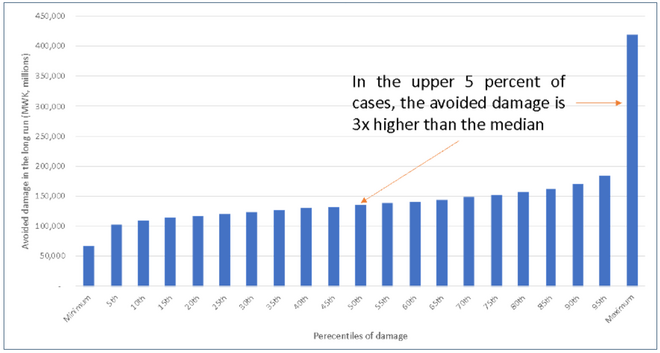Malawi Priorities: Disaster Risk Reduction
Technical Report
Key Messages
- Malawi is highly vulnerable to the impacts of extreme weather events. The adverse effects of climate change pose a significant risk to Malawi’s growth and development, with the nation having faced continual and compounding disasters over the last few decades. The impacts of extreme weather events in Malawi, such as floods, strong winds, dry spells, cyclones, earthquakes, and landslides, are substantial – hindering Malawian lives, livelihoods, the country’s economy, and damaging infrastructure.
- On average, floods constitute about 75% of annual average losses estimated at MWK 50,600 million (USD 68 million) on average. However, the average damage does not convey the size of the tail risk – i.e. extreme events with substantially higher damages. For example, the floods of 2015, and the drought which followed in 2016, raised the national poverty rate and resulted in losses valued at approximately MWK 521,500 million (US $700 million), while more recently, in 2019, physical damage to the country was estimated at MWK 163,900 million (USD 220 million) as a result of Cyclone Idai.
- The analysis recommends prioritizing improvements in Malawi’s Early Warning Systems (EWS) as more effective use of marginal resources toward improving Malawi’s resilience to floods. Overall, this intervention would yield 16 kwacha in benefits for every kwacha invested, indicating the high socio-economic efficiency of the EWS improvements for Malawi.
- The EWS improvements require an upfront capital investment of MWK 3,371 million followed by an annual maintenance cost of MWK 506 million. The costs are relatively modest, due to the fact that the investments focus on improvements over the existing EWS system. The benefits obtained are mainly from avoided damage, with the analysis estimating that 10% of housing and property damage; 70% of livestock, and 80% of health damage could be avoided with more comprehensive responses to EWS advisories for major floods, and up to 25% of total damage could be avoided in the case of minor floods. The expected value of damage avoided is around MWK 14,000 million annually, however, the benefits are skewed towards incidents that occur rarely but have a high impact.
- The analysis also considers Climate-Smart Agriculture (CSA), as a second intervention, combining integrated conservation agriculture with crop diversification, drought-tolerant varieties, and rice intensification. This intervention would yield 3.0 kwacha in benefits for every kwacha invested.
Context
Malawi has faced continual and compounding disasters over the last few decades, with The Intergovernmental Panel for Climate Change’s (IPCC) Fifth Assessment Report (AR5) identifying the country at high risk to the adverse effects of climate change. Rapid population growth, poverty, unsustainable urbanization, climate variability and change, and environmental degradation further contribute to its susceptibility in that regard. The wide variety of natural hazards that the country is exposed to includes floods, strong winds, dry spells, cyclones, earthquakes, and landslides.
The growth and stability of Malawi’s people's livelihoods, economy, and infrastructure have all been impacted and hindered by these extreme weather events. The floods of 2015, and the drought which followed in 2016, raised the national poverty rate and resulted in losses valued at approximately MWK 521,500 million (USD $700 million), while more recently, in 2019, physical damage to the country was estimated at MWK 163,900 million (USD 220 million) as a result of Cyclone Idai.
Over the past five decades, Malawi has experienced more than 19 major flooding incidents and seven droughts. Mean annual temperatures have been consistently increasing, going up by 0.9 degrees Celsius over the period from 1960 to 2006 (Vincent et al. 2013). There is a high level of variation between average annual rainfalls, with very high levels of rainfall in 1989, 1997, and 2015, while by contrast, 1992, 2005, 2008, and 2016 were very dry.
These fluctuations add to the necessity of disaster management and relief planning given the wide spectrum of activities needed to build resilience. This analysis conducts cost-benefit analyses on two interventions that are critical to improving Malawi’s resilience, as identified by sector experts in the country. These two interventions respond primarily to the occurrence of floods and drought - EWS improvements and expanding the use of CSA practices.
Investing in EWS improvements would generate excellent economic benefits for Malawi
Malawi is highly vulnerable to the impacts of extreme weather events. On average, floods constitute about 75% of losses estimated at $68M in a typical year. EWS plays an essential role in the mitigation of damage from natural disasters by providing an essential but marginal reduction in exposure. The ultimate role of EWS is to help potentially exposed communities better prepare for an upcoming extreme weather event: protect property, leave potentially exposed areas for shelter, move livestock to the high ground, etc. In other words, EWS improves the last mile coverage of disaster response at the community level.
The short term costs associated with improving Malawi’s EWS include conducting hazard, vulnerability, and risk assessments, along with zoning of 15 districts and 2 city councils (MWK 1117.5 million), providing a return package to households in displaced sites (MWK 372.5 million); reviewing the National Disaster Recovery Framework to incorporate 2019 Post-Disaster National Assessment issues (MWK 260.8 million) and reviewing the disaster impact and needs assessment and reporting to include recovery needs (MWK 186.3 million). Midterm costs are estimated to be MWK 1378 million, and include rehabilitation and strengthening of automated community EWS (MWK 373 million), establishing and training civil protection committees (CPCs) at MWK 261 million, and training and strengthening local search and rescue team with the necessary equipment at MWK 745 million.
The analysis estimates that the intervention would avoid about 10% of housing and property damage; 70% of livestock and 80% of health damage in the event of a major flood with the proper response to EWS advisory. For a minor flood, a larger fraction of damage could be avoided - up to 25% of total damage could be avoided. The total benefits accrued would amount to approximately MWK 14,000 million per year on average. This is an expected value, reflecting the benefits of avoiding impacts across the possibility of outcomes, including low probability but high impact events.
The analysis also considers Climate-Smart Agriculture (CSA), as a second intervention, combining integrated conservation agriculture with crop diversification, drought-tolerant varieties, and rice intensification. This intervention would yield 3.0 kwacha in benefits for every kwacha invested.
Overall, the results indicate that out of the two options, improvements in EWS are a more effective use of marginal resources compared to climate-smart agriculture strategies. This is not to say that CSA should be overlooked, just that out of the two, EWS improvements should be prioritized by a welfare-maximizing decision-maker with limited resources. The logic behind this finding is that successfully integrating CSA policies requires engaging and changing the behavior of millions of smallholder farmers in the face of an important, but relatively slow-acting disaster (drought). The scale of engagement required renders this intervention particularly costly. In contrast, EWS improvements require only modest additional costs, since the base infrastructure of EWS is already established. The scale of engagement required to enact change is large but can leverage community-level structures at a much lower cost. The relatively acute and obvious nature of the disaster (flood) also lends itself to more rapid behavior change, if sufficient warning is provided.
Figure 1: The greatest benefit from EWS is avoiding impacts from the worst disasters that tend to occur infrequently

Summary Table
| Intervention | BCR | Cost | Benefit |
|---|---|---|---|
| Early Warning Systems (EWS) Improvements | 16 Excellent |
MWK 3,371 million (upfront capital investment costs in the first year) + ongoing annual maintenance costs of MWK 506 million | Approx. MWK 14,000 million per year with much of the benefit from avoided tail risk During Floods: 10% housing damage avoided 70% livestock loss avoided 80% lives lost avoided |
| Expanding the use of Climate Smart Agriculture (CSA) practices to address drought and floods | 3.0 Fair |
Incremental farm costs relative to uptake of CSA practices of between MWK 803 million (10% uptake) to MWK 4,815 million (60% uptake) + extension costs (average MWK 43,556 million for 5 years) | Income benefits increase over 5 years rising from MWK 8,025 million to MWK 48,151 million at steady state + avoided humanitarian aid averaging MWK 43,412 million per year |
Note: BCRs are based on costs and benefits discounted at 8% (see accompanying technical report). BCR ratings are determined on the following scale Excellent, BCR > 15; Good, BCR 5-15; Fair, BCR 1-5; Poor, BCR < 1. This traffic light scale was developed by an Eminent Panel including several Nobel Laureate economists for a previous Copenhagen Consensus project that assessed the Sustainable Development Goals.
Download the full policy brief here.

